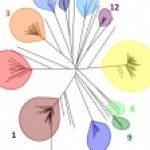Link to Pubmed [PMID] – 11923347
J. Clin. Microbiol. 2002 Apr;40(4):1290-7
Molecular characterization of Candida albicans isolates is essential for understanding the epidemiology of nosocomial infections caused by this yeast. Here, we investigated the potential value of multilocus sequence typing (MLST) for characterizing epidemiologically related or unrelated C. albicans strains of various clinical origins. Accordingly, we sequenced the internal regions (loci) of six selected housekeeping genes of 40 C. albicans clinical isolates and 2 reference strains. In all, 68 polymorphic nucleotide sites were identified, of which 65 were found to be heterozygous in at least one isolate. Ten to 24 different genotypes were observed at the different loci, resulting, when combined, in 39 unique genotype combinations or diploid sequence types (DSTs). When MLST was applied to 26 epidemiologically unrelated isolates and the 2 reference strains, it allowed the identification of 27 independent DSTs, thus demonstrating a discriminatory power of 99.7. Using multidimensional scaling together with the minimum spanning tree method to analyze interstrain relationships, we identified six groups of genetically related isolates on the basis of bootstrap values of greater than 900. Application of MLST to 14 epidemiologically related isolates showed that those recovered from patients in the same hospital ward during the same 3 months had specific DSTs, although 73% of these isolates were genetically very close. This suggests that MLST can trace minute variations in the sequences of related isolates. Overall, MLST proved to be a highly discriminatory and stable method for unambiguous characterization of C. albicans.



